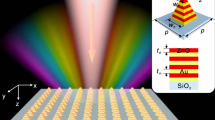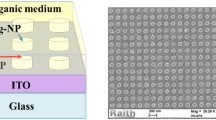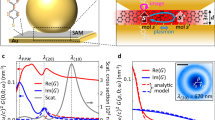Abstract
Plasmonic nanostructures have been extensively used to manipulate the spontaneous light emission rate of molecules and their radiative efficiency1,2,3,4,5,6. Because molecules near a metallic surface experience a different environment than in free space, their spontaneous radiative emission rate is generally enhanced7,8,9. Such enhancement, measured by means of the Purcell factor, arises as a consequence of the overlap between the surface plasmon mode frequency and the emission spectrum of the molecule. However, such overlap is available only for a few narrow bands of frequency due to the limited plasmonic materials existing in nature10,11. Although this limitation can be overcome by using hyperbolic metamaterials (HMMs)—a type of nanoscale artificial material with hyperbolic dispersion relations—the Purcell factor and the radiative power have remained relatively low12,13,14,15,16. Here, we show that by nanopatterning a hyperbolic metamaterial made of Ag and Si multilayers, the spontaneous emission rate of rhodamine dye molecules is enhanced 76-fold at tunable frequencies and the emission intensity of the dye increases by ∼80-fold compared with the same hyperbolic metamaterial without nanostructuring. We explain these results using a dynamic Lorentzian model in the time domain.
This is a preview of subscription content, access via your institution
Access options
Subscribe to this journal
Receive 12 print issues and online access
$259.00 per year
only $21.58 per issue
Buy this article
- Purchase on Springer Link
- Instant access to full article PDF
Prices may be subject to local taxes which are calculated during checkout





Similar content being viewed by others
References
Barnes, W. L., Dereux, A. & Ebbesen, T. W. Surface plasmon subwavelength optics. Nature 424, 824–830 (2003).
Schuller, J. A. et al. Plasmonics for extreme light concentration and manipulation. Nature Mater. 9, 193–204 (2010).
Shimizu, K. T., Woo, W. K., Fisher, B. R., Eisler, H. J. & Bawendi, M. G. Surface-enhanced emission from single semiconductor nanocrystals. Phys. Rev. Lett. 89, 117401 (2002).
Anger, P., Bharadwaj, P. & Novotny, L. Enhancement and quenching of single-molecule fluorescence. Phys. Rev. Lett. 96, 113002 (2006).
Okamoto, K. et al. Surface-plasmon-enhanced light emitters based on InGaN quantum wells. Nature Mater. 3, 601–605 (2004).
Cho, C-H. et al. Tailoring hot-exciton emission and lifetimes in semiconducting nanowires via whispering-gallery nanocavity plasmons. Nature Mater. 10, 669–675 (2011).
Purcell, E. M. Spontaneous emision probabilities at radio frequencies. Phys. Rev. 69, 681 (1946).
Lakowicz, J. R. Radiative decay engineering 5: metal-enhanced fluorescence and plasmon emission. Anal. Biochem. 337, 171–194 (2005).
Fort, E. & Gresillon, S. Surface enhanced fluorescence. J. Phys. D 41, 013001 (2008).
Ford, G. W. & Weber, W. H. Electromagnetic interactions of molecules with metal surfaces. Phys. Rep. 113, 195–287 (1984).
Barnes, W. L. Fluorescence near interfaces: the role of photonic mode density. J. Mod. Opt. 45, 661–699 (1998).
Krishnamoorthy, H. N. S., Jacob, Z., Narimanov, E., Kretzschmar, I. & Menon, V. M. Topological transitions in metamaterials. Science 336, 205–209 (2012).
Jacob, Z. et al. Engineering photonic density of states using metamaterials. Appl. Phys. B 100, 215–218 (2010).
Ni, X. et al. Effect of metallic and hyperbolic metamaterial surfaces on electric and magnetic dipole emission transitions. Appl. Phys. B 103, 553–558 (2011).
Tumkur, T. et al. Control of spontaneous emission in a volume of functionalized hyperbolic metamaterial. Appl. Phys. Lett. 99, 151115 (2011).
Kim, J. et al. Improving the radiative decay rate for dye molecules with hyperbolic metamaterials. Opt. Express 20, 8100–8116 (2012).
Liu, Z., Lee, H., Xiong, Y., Sun, C. & Zhang, X. Far-field optical hyperlens magnifying sub-diffraction-limited objects. Science 315, 1686–1701 (2007).
Zhang, X. & Liu, Z. Superlenses to overcome the diffraction limit. Nature Mater. 7, 435–441 (2008).
Zheludev, N. I. & Kivshar, Y. S. From metamaterials to metadevices. Nature Mater. 11, 917–924 (2012).
Lu, D. & Liu, Z. Hyperlenses and metalenses for far-field super-resolution imaging. Nature Commun. 3, 1205 (2012).
Cortes, C. L., Newman, W., Molesky, S. & Jacob, Z. Quantum nanophotonics using hyperbolic metamaterials. J. Opt. 14, 063001 (2012).
Jacob, Z. & Shalaev, V. M. Plasmonics goes quantum. Science 334, 463–464 (2011).
Yang, X., Yao, J., Rho, J., Yin, X. & Zhang, X. Experimental realization of three-dimensional indefinite cavities at the nanoscale with anomalous scaling laws. Nature Photon. 6, 450–454 (2012).
Cui, Y. et al. Ultrabroadband light absorption by a sawtooth anisotropic metamaterial slab. Nano Lett. 12, 1443–1447 (2012).
Selanger, K. A., Falnes, J. & Sikkeland, T. Fluorescence lifetime studies of Rhodamin 6G in methanol. J. Phys. Chem. 81, 1960–1963 (1977).
Wang, J., Chabanov, A. A., Lu, D. Y., Zhang, Z. Q. & Genack, A. Z. Dynamics of mesocopic fluctuations of localized waves. Phys. Rev. B 81, 241101 (2010).
Stringari, C. et al. Phasor approach to fluorescence lifetime microscopy distinguishes different metabolic states of germ cells in a live tissue. Proc. Natl Acad. Sci. USA 108, 13582–13587 (2011).
Acknowledgements
The authors acknowledge financial support from an Office of Naval Research (ONR) Young Investigator Award (no. N00014-13-1-0535), the National Science Foundation–Electrical, Communications and Cyber Systems (NSF-ECCS) (grant no. 0969405) and the National Science Foundation–Civil, Mechanical and Manufacturing Innovation (NSF-CMMI) (grant no. 1120795). The authors thank P. Zhang for help with STEM characterization and M. Digman, E. Gratton, L. Feng, H. Chen and Y. Liu for assistance during various phases of simulations and experiments. The time-resolved photoluminescence measurements were carried out at the Laboratory for Fluorescence Dynamics (LFD) at the University of California, Irvine (UCI). The LFD is supported jointly by the National Center for Research Resources (5P41RR003155-27), the National Institute of General Medical Sciences of the National Institutes of Health (8P41GM103540) and UCI.
Author information
Authors and Affiliations
Contributions
Z.L. conceived the concept. D.L. performed numerical modelling and simulations, in detail. J.J.K. and D.L. fabricated the samples. D.L. performed the optical experiments and prepared all the figures. D.L., Z.L. and J.J.K. wrote the manuscript. All authors discussed the results and commented on the manuscript. Z.L. supervised the project.
Corresponding author
Ethics declarations
Competing interests
The authors declare no competing financial interests.
Supplementary information
Supplementary information
Supplementary Information (PDF 1458 kb)
Rights and permissions
About this article
Cite this article
Lu, D., Kan, J., Fullerton, E. et al. Enhancing spontaneous emission rates of molecules using nanopatterned multilayer hyperbolic metamaterials. Nature Nanotech 9, 48–53 (2014). https://doi.org/10.1038/nnano.2013.276
Received:
Accepted:
Published:
Issue Date:
DOI: https://doi.org/10.1038/nnano.2013.276
This article is cited by
-
Analysis of Dielectric Properties of Inhomogeneous Anisotropic Dye-Coated Nanoparticles
Plasmonics (2024)
-
Observation of large spontaneous emission rate enhancement of quantum dots in a broken-symmetry slow-light waveguide
npj Quantum Information (2023)
-
Gigantic suppression of recombination rate in 3D lead-halide perovskites for enhanced photodetector performance
Nature Photonics (2023)
-
Tunable optical topological transitions of plasmon polaritons in WTe2 van der Waals films
Light: Science & Applications (2023)
-
Hyperbolic metamaterials: fusing artificial structures to natural 2D materials
eLight (2022)



